Table of Contents
Does Polyester Have PFAS? Unveiling "Forever Chemicals" in Your Clothes
This page may contain affiliate links. We may earn a commission on purchases, at no additional cost to you. Learn more →
Are you worried about what’s hiding in your clothes? You choose your food carefully and your beauty products even more so, but the fabrics touching your skin all day might be exposing you to harmful chemicals.
Have you ever wondered if they're hiding in your favorite polyester workout gear or that water-resistant jacket hanging in your closet? While polyester itself doesn't contain PFAS, many synthetic fabric garments are treated with these persistent chemicals to achieve that convenient water-repelling or stain-resistant finish you've come to rely on.
These synthetic chemicals nicknamed “forever chemicals” because they don’t break down in the environment and can accumulate in human body over time, posing serious health risks, from cancer to hormone disruption.
The problem is that clothing labels don't list these chemical substances, leaving you in the dark.
You need to know what's really touching your skin every day and how to protect yourself and your family from unnecessary exposure. This guide will pull back the curtain on PFAS in polyester and toxic fashion, explaining the risks and empowering you with practical, actionable advice to protect yourself and your family.
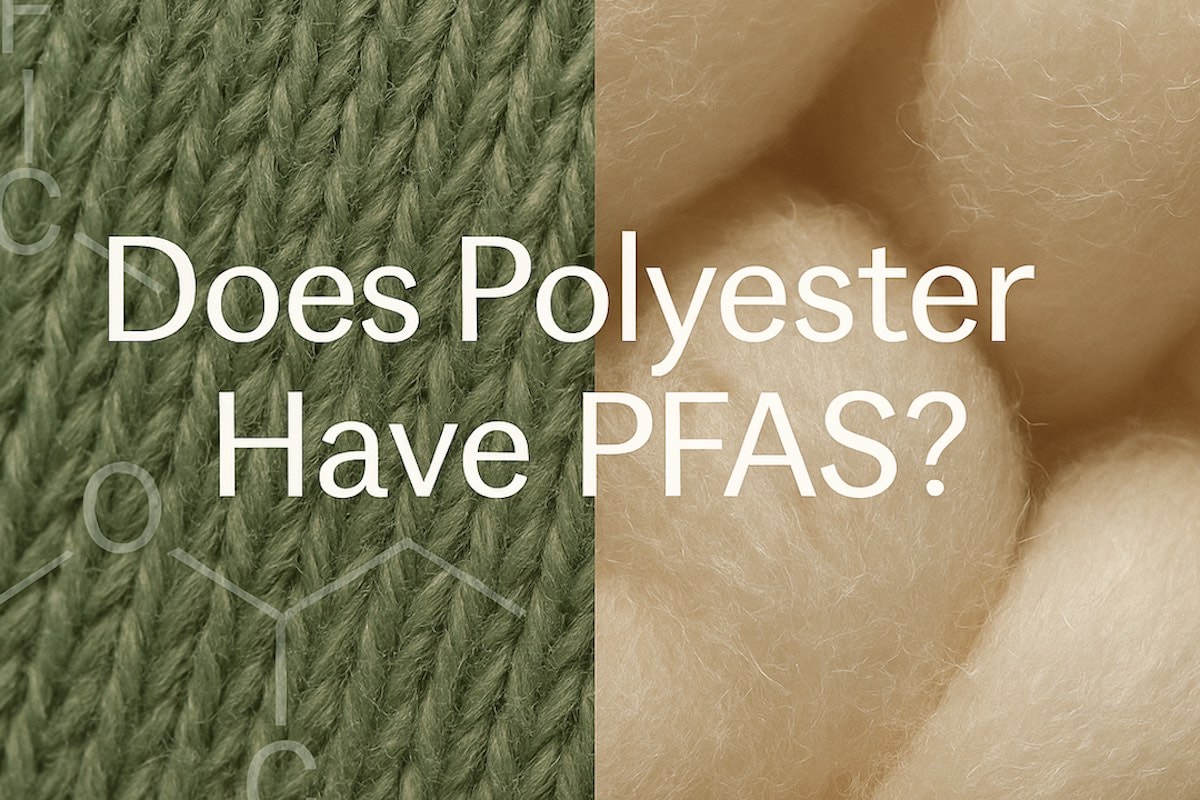
Key Takeaways
-
Polyester vs PFAS: Untreated polyester fiber is generally PFAS-free, but many polyester garments receive PFAS-based treatments for water, oil, or stain resistance
-
Health Risks: PFAS exposure is linked to hormone disruption, certain cancers, weakened immunity, and developmental issues—and these chemicals can remain in your body for years
-
Widespread in Apparel: Testing reveals that PFAS are common in apparel. A 2022 study found that65% of all tested children's clothing contained PFAS treatments. Another analysis found PFAS in nearly 72% of products marketed as water- or stain-resistant.
-
Environmental Impact: PFAS-treated textiles pollute air, water, and soil throughout their lifecycle, contributing to global contamination
-
Regulatory Action: States like California and New York are banning PFAS in most apparel starting in 2025. Many major brands have also pledged to eliminate PFAS from their products.
-
Safer Alternatives: PFAS-free options using silicone, wax-based repellents, or tightly woven fabrics offer similar performance without the risks. You can identify and avoid PFAS by reading labels carefully, choosing certified products, and prioritizing natural, untreated fibers
Introduction: Polyester, PFAS, and Why It Matters
Polyester is the world's dominant textile fiber,found in everything from your moisture-wicking gym clothes to the rain jacket.
In its basic form, as a synthetic plastic fiber, polyester contains no PFAS in its molecular structure. So, why the concern? Because in real-world use, manufacturers often add PFAS-based treatments to polyester fabrics to give them special properties like water and stain repellency. This means that many polyester products on the market do contain PFAS.
This distinction is crucial. You might think your polyester jacket is chemically inert, but in reality, it could be coated in toxic "forever chemicals." When you wear clothing treated this way or wash these items, you could be unknowingly exposing yourself and the environment to persistent toxic chemicals.
Over the past decade, scientists and environmental health experts have grown alarmed about PFAS in consumer products—not just in non-stick pans, but in our wardrobes. Research has linked PFAS to a "range of serious health problems", including cancer and immune dysfunction. In 2022, after testing dozens of stain-resistant textiles, researchers from Toxic-Free Future flatly concluded that brands are "needlessly putting customers' health at risk" by using PFAS finishes.
Meanwhile, government bodies are catching up. The fact that no U.S. federal law yet requires disclosure of PFAS in clothing has been called a regulatory blind spot.
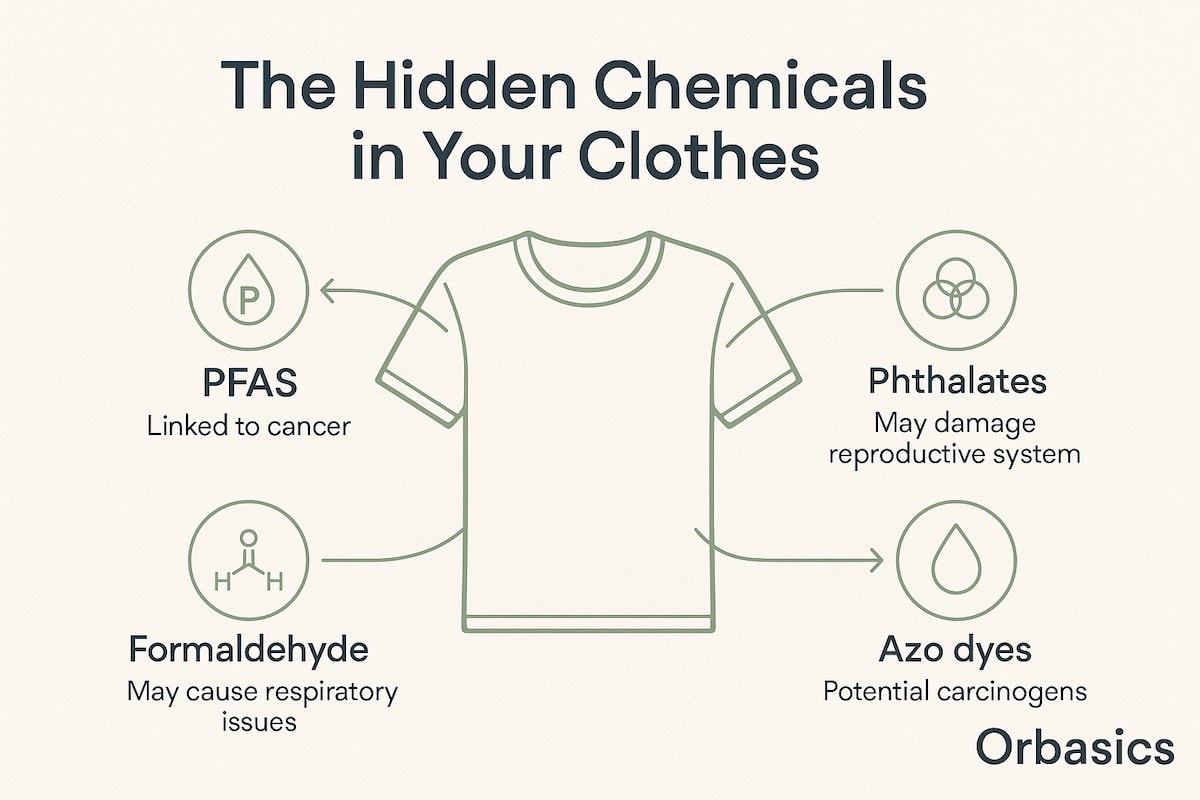
What Are PFAS, and Why Are They Used on Fabrics?
To understand the link between PFAS and polyester, it's important to know what PFAS are and why they are used on fabrics.
PFAS Defined
Per- and polyfluoroalkyl substances (PFAS) are a large family of man-made chemicals valued for their resistance to water, oil, and heat. Their strong carbon-fluorine bond makes them extremely stable and difficult to break down, which is why they are called "forever chemicals" . Since the 1940s, PFAS have been used in countless products, from nonstick cookware to waterproof textiles.
How PFAS End Up in Your Clothes
In the apparel industry, PFAS are used in two main ways:
-
Durable Water Repellent (DWR) Finishes: These are surface coatings that make liquids bead up and roll off fabrics. They are commonly used on rain jackets, outdoor gear, and upholstery.
-
Membranes and Laminates: Some high-performance outdoor garments use a PFAS membrane, like GORE-TEX®, which is a thin film that blocks water while allowing vapor to escape.
PFAS have been the go-to solution for water and stain repellency because of their effectiveness. However, the same chemical stability that makes them ideal for repelling water also makes them a problem for our health and the environment.
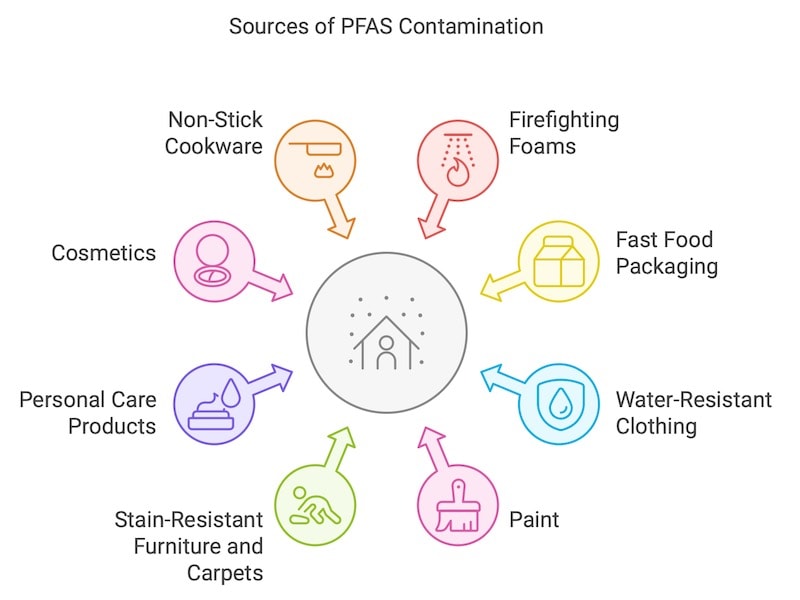
Human Health Concerns: How PFAS in Polyester Clothing Can Affect You
Wearing PFAS-treated clothing might seem harmless, but emerging research suggests otherwise. While most PFAS exposure comes through contaminated food and water, your clothing represents an additional, often overlooked exposure route.
Known Health Risks
Extensive research has linked PFAS exposure to alarming health outcomes:
-
Cancer: Studies confirm associations between certain PFAS and kidney, testicular, liver, and pancreatic cancers
-
Hormone Disruption: PFAS interfere with thyroid hormones and reproductive systems, potentially affecting fertility and development
-
Immune Suppression: High PFAS levels correlate with weakened vaccine response and increased infection risk in children
-
Reproductive Harm and Developmental Issues: Studies have linked PFAS to lower fertility and developmental delays in children.
-
Metabolic Effects: Links to elevated cholesterol, weight gain, hypertension during pregnancy, and liver enzyme changes
Can PFAS Move from Clothing to Your Body?
Your skin isn't an impenetrable barrier. Research from the National Institute for Occupational Safety and Health found that PFAS can be absorbed through skin at levels similar to ingestion under certain conditions. Shorter-chain PFAS (C≤8) are absorbed more efficiently through skin, while longer chains tend to remain on the surface and may be absorbed later. Heat, friction, and moisture—exactly what happens when you wear tight polyester sportswear during exercise—can enhance this transfer.
Environmental chemist Dr. Stuart Harrad's research discovered PFAS in skin oils and sweat from people wearing treated fabrics. While transdermal absorption is likely lower than oral exposure, he cautions it's "certainly something we shouldn't ignore."
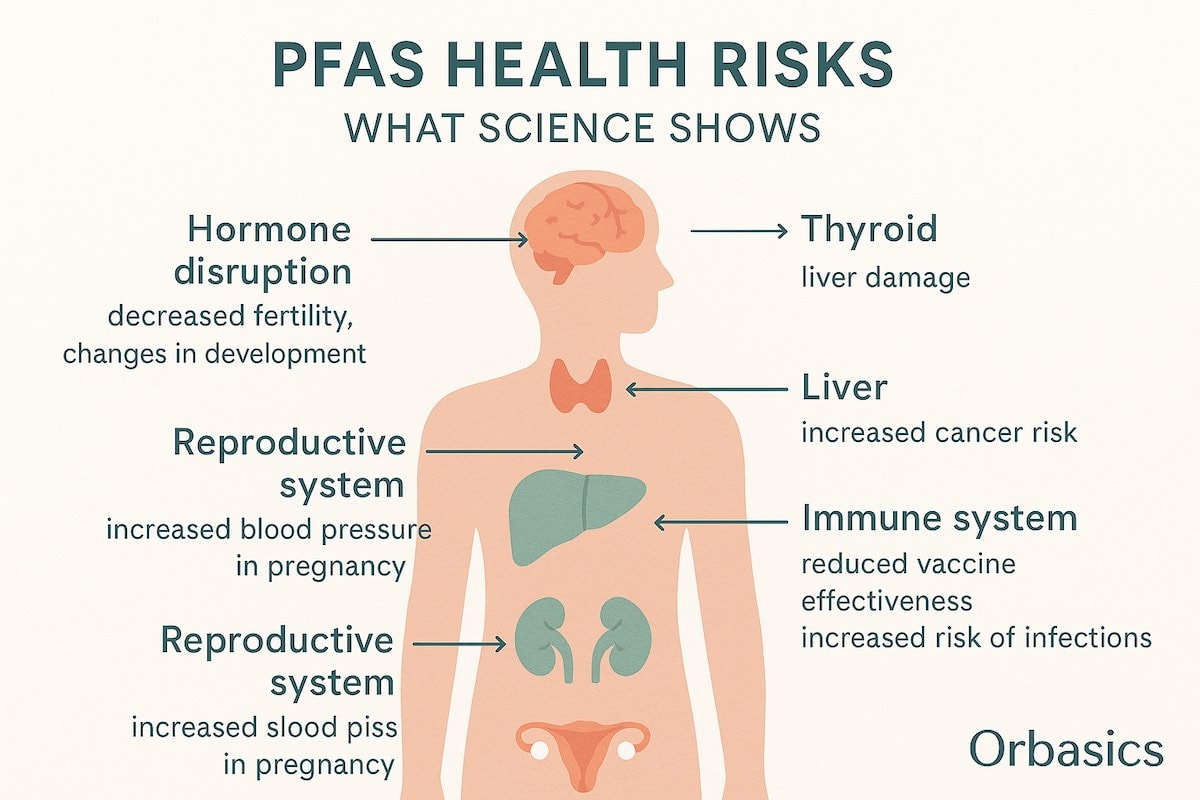
The Chemical Cocktail Effect
Your polyester garments often contain a "chemical cocktail" and volatile organic compounds beyond PFAS, including:
-
Formaldehyde for wrinkle resistance
-
Acetaldehyde and other aldehydes: Released during wear and heating
-
Antimony compounds: Trace emissions from antimony trioxide catalyst used in production
-
Antimicrobials like triclosan
-
BPA and BPS from processing
-
Phthalates from prints and elastics
-
Potentially carcinogenic disperse dyes
This combination creates an "accumulation of exposures" that can be harmful over time. Each polyester item's contribution might seem tiny, but the cumulative effect of constant, multi-source exposure adds up.
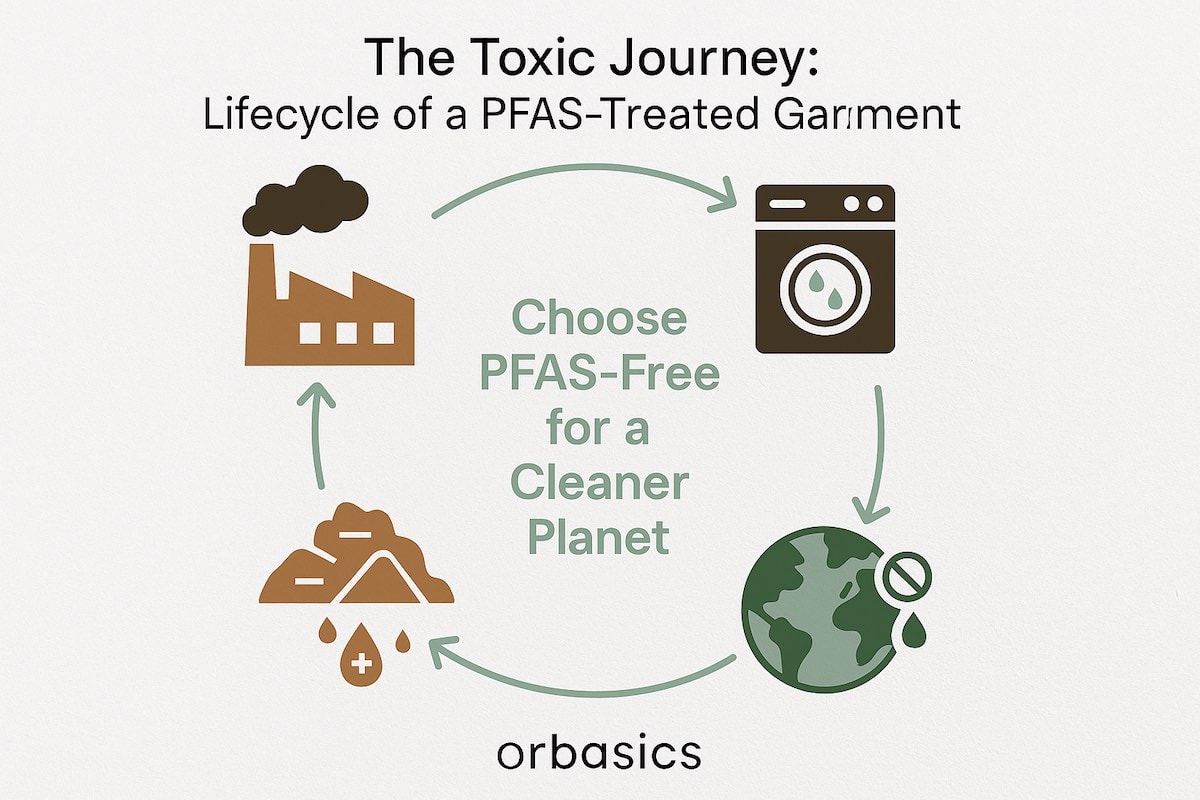
Environmental Impact: PFAS Pollution from Textiles
Every stage of a PFAS-coated garment's life cycle releases these chemicals into the environment, where they persist indefinitely.
Manufacturing Contamination
PFAS production for textiles often occurs in facilities with loose environmental controls. Communities near textile mills have documented PFAS contamination in local water and soil. These pollutants don't stay local—they travel through air emissions and water systems, contributing to global dispersion.
Indoor Air Pollution
PFAS finishes gradually flake off as dust or fumes. Studies have found elevated PFAS levels in indoor dust where treated fabrics are stored, creating an inhalation exposure pathway—especially concerning for crawling infants and toddlers.
Washing and Wastewater
When you launder PFAS-treated polyester, chemicals wash out into wastewater. Since treatment plants can't effectively filter PFAS, these chemicals enter rivers and groundwater. The treated sludge, often used as fertilizer, creates additional contamination hotspots.
End-of-Life Pollution
Discarded PFAS-treated clothing continues polluting through:
-
Landfills: PFAS leach into groundwater through rainwater
-
Incineration: Standard temperatures don't destroy PFAS, releasing them into air
-
Recycling challenges: PFAS contamination undermines textile recycling efforts
Global Bioaccumulation
PFAS from textiles contribute to a worldwide pollution crisis. These chemicals have been detected in Arctic ice, deep ocean water, wildlife, and the blood of 99% of Americans. They accumulate up the food chain, ultimately returning to us through contaminated food and water.
How to Avoid PFAS in Clothing: Practical Guide for Consumers
You can take immediate steps to reduce your PFAS exposure from clothing.
1. Decode Product Labels
Look for red flags indicating likely PFAS treatment:
-
"Water-resistant," "waterproof," "stain-resistant"
-
"Moisture-wicking," "permanent press"
-
"Teflon coating" (a definite PFAS indicator)
Unless explicitly labeled "PFAS-free," assume these features come from chemical treatments.
2. Seek Certifications and PFAS-Free Claims
-
OEKO-TEX® Standard 100: Tests for 100+ harmful substances including PFAS
-
Bluesign® Approved: Indicates safer chemical processes
-
PFAS-Free Product Lists: Check resources like PFAS Central for verified options
-
Ask brands directly: Email customer service about PFAS-free alternatives
3. Choose Natural, Untreated Fabrics
Prioritize organic cotton, wool, silk, hemp, and linen for everyday wear. These naturally don't require PFAS unless specifically treated for special properties.
4. Handle "Recycled" Materials Polyester
Recycled polyester can still receive PFAS treatments. Don't assume eco-friendly materials mean chemical-free—verify finishing treatments independently.
5. Smart Shopping for Performance Gear
When you need technical clothing:
-
Research brands offering PFAS-free versions (many now available)
-
Consider alternatives like waxed canvas or multi-layered construction
-
Look for "C0 DWR" (fluorine-free repellent) specifications
6. Minimize Exposure from Existing Clothes
-
Wash 2-3 times before first wear to remove surface chemicals
-
Air-dry new items outdoors for 24-48 hours to allow off-gassing
-
Avoid heat exposure: Don't use high-heat settings when drying polyeste
-
Limit wearing suspected PFAS-treated items directly on skin
-
Use cotton underlayers as barriers
-
Rotate clothing to reduce constant exposure
7. Stay Updated
Follow trusted sources like the Environmental Working Group and NRDC for emerging information about safer alternatives and new regulations.
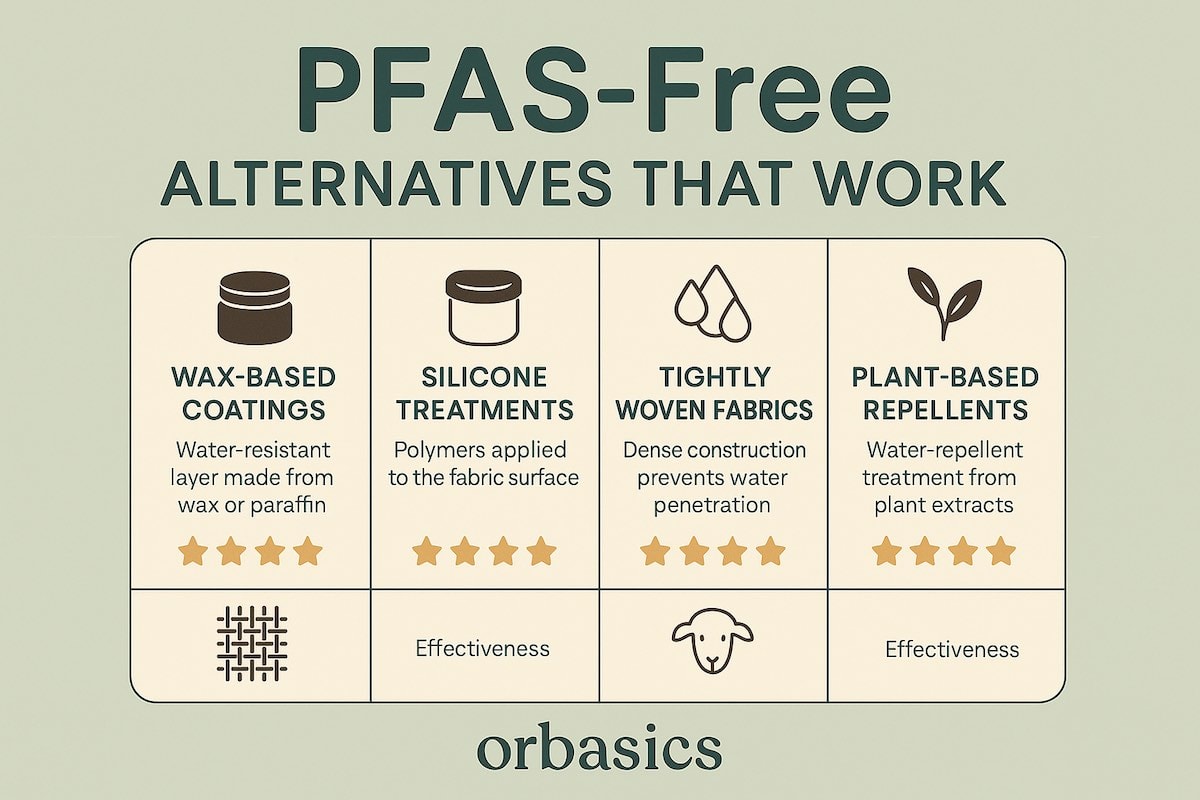
Conclusion: Polyester and PFAS – Navigating the Future of "Forever Chemicals" in Fashion
So, does polyester have PFAS? The answer is nuanced: the fabric itself does not, but many polyester products do because of added chemical treatments. These "forever chemicals," added for convenience, pose a persistent threat to our health and the environment.
The key takeaways are clear: PFAS are widespread in our clothing, they can migrate into our bodies and ecosystems, and both regulators and brands are starting to respond. By 2025, new laws in several states will make it much harder to find PFAS-treated garments. This marks a positive shift for the future of our wardrobes.
Even before these changes take full effect, you have the power to make a difference. By choosing PFAS-free products, prioritizing natural fibers, and demanding transparency from brands, you can build a wardrobe that is both high-performing and healthy. The story of PFAS in polyester is a lesson in the broader sustainable fashion movement. It highlights the importance of looking beyond the price tag and aesthetics to understand how our clothes are made and what they are made with.
FAQ – Does Polyester Have Pfas
Does polyester contain PFAS?
Polyester fibers themselves don't inherently contain PFAS, but many finished polyester products have PFAS-based coatings or treatments. If a polyester item is advertised as water-repellent or stain-proof, it's likely been treated with PFAS unless explicitly stated otherwise.
What fabric has no PFAS?
Natural materials are inherently PFAS-free because they don't require chemical coatings for their basic functionality. The safest fabric options include organic cotton, which is grown without synthetic pesticides and processed without chlorine bleach or formaldehyde. Hemp is another excellent choice, requiring no pesticides and minimal processing while being naturally antimicrobial and 3.3 times more durable than cotton. Linen, made from flax plants, offers natural breathability and requires very little chemical intervention during production. Wool provides temperature regulation and antimicrobial properties naturally, though it's important to ensure it hasn't been treated with moth-proofing chemicals. For guaranteed PFAS-free options, look for TENCEL™ Lyocell, which is made from wood pulp using a closed-loop, non-toxic solvent system. Other safe natural options include bamboo viscose (when OEKO-TEX certified), silk, and hemp blends.
Is polyester a toxic material?
While polyester isn't directly toxic in the traditional sense, it presents several health concerns. Polyester is a synthetic plastic fabric that releases microplastics when washed and can contain harmful chemicals like PFAS, antimony trioxide and others used during production. Polyester also traps heat and moisture against the skin, creating bacterial breeding grounds that can lead to breakouts and rashes.
What materials contain PFAS?
PFAS ("forever chemicals") are found in numerous consumer products including water-resistant outdoor clothing and activewear, stain-resistant carpets and upholstery, non-stick cookware, food packaging, firefighting foam, and personal care products like dental floss and cosmetics. In textiles specifically, PFAS are commonly used in waterproof jackets, sportswear, school uniforms, and any fabric marketed as "moisture-wicking," "stain-resistant," or "water-repellent".
How can I tell if my clothes have PFAS?
Look for clues like "water-resistant," "stain-resistant," "Teflon coating," or "moisture-wicking" in product descriptions, as these often indicate PFAS treatments. Unless a garment is explicitly marked "PFAS-free" or certified by OEKO-TEX®, it's safest to assume synthetic apparel with water or stain repellency uses PFAS.
Is recycled polyester free of toxic chemicals like PFAS?
Not necessarily—recycled polyester fabric can still be treated with PFAS finishes just like virgin polyester. Recycling addresses the fiber source but doesn't guarantee absence of chemical coatings, so evaluate finishing treatments regardless of recycled content.













